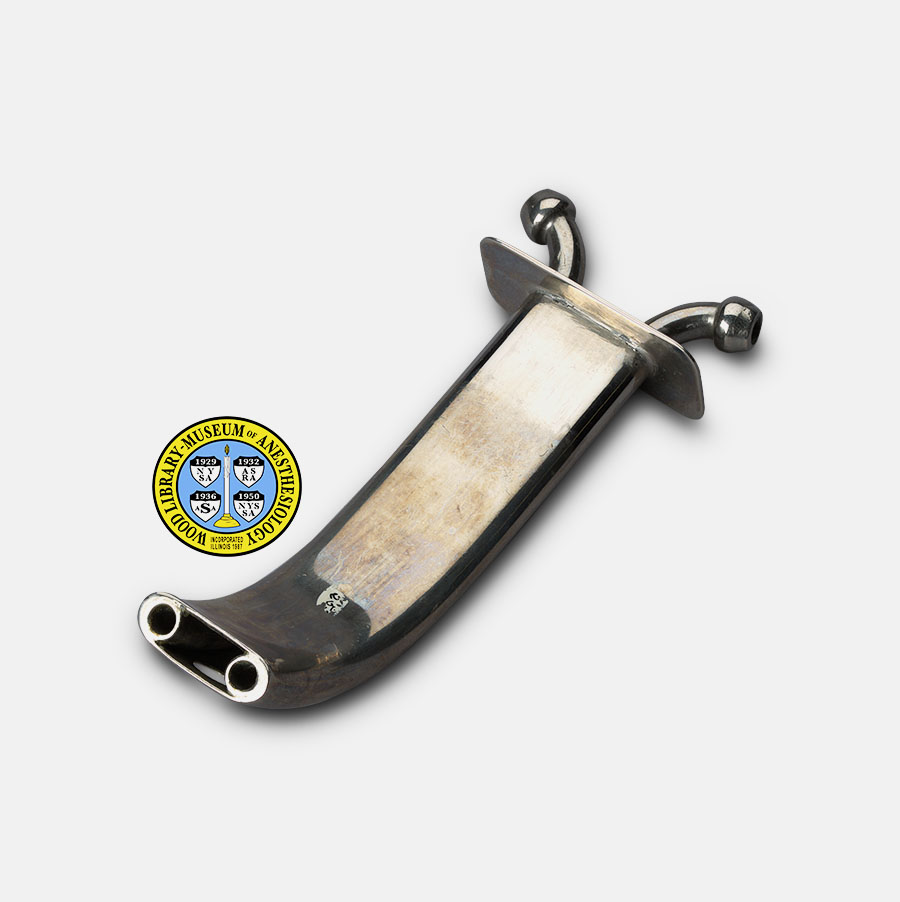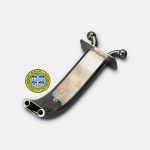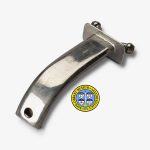Poe Airway
Anesthesia can reduce the body’s ability to breathe normally. Anesthesiologists often make use of artificial airways, which are inserted over the tongue, to help maintain a clear passage through which the patient can breathe. Before endotracheal tubes came into common use, oral airways also provided a conduit for delivering anesthetic gases to the patient.
James G. Poe, M.D. (1873-1935) was the first physician anesthetist to be employed by Baylor University in Dallas, Texas, where he became chief of the anesthesia staff and a lecturer. In 1926, he published the first anesthesia textbook produced in Texas. He was also an inventor, and patented this airway in 1924. The device has three separate channels. The center channel functions as the airway, while on either side of this there is a built-in insufflation tube. Each insufflation tube has a nipple to which a hose can be attached for the delivery of gases. The Poe Airway was sold by the New York-based Foregger Company from 1926 through 1942.
Dr. Poe also designed a simple airway for use in the recovery room. Both his insufflating airway and his “recovery airway” came equipped with a rubber mouthpiece (missing in this example) that protected the patient’s teeth.
Catalog Record: Poe Airway
Access Key: amyd
Accession No.: 2016-01-18-1
Title: [Poe airway] / [designed by James G. Poe].
Author: Poe, James Granger, 1873-1935.
Title variation: Alt Title
Title: Poe Airway for Insufflation, Suction and Induction.
Title variation: Alt Title
Title: Poe Throat Tube.
Publisher: [New York]: Foregger, [between 1926 and 1948].
Physical Descript: 1 airway : metal ; 2.5 x 4.5 x 11.5 cm.
Subject: Airway Management – instrumentation.
Subject: Airways, Artificial.
Subject: Anesthesia, Inhalation – instrumentation.
Subject: Oropharyngeal Airway Devices.
Note Type: General
Notes: Called by the manufacturer the “Poe Airway, For Insufflation, Suction and
Induction”, this is distinct from the “Poe Recovery Airway (For
Post-Operative Treatment)”. The earliest year in the date range is based on
the earliest Foregger Company catalog in the WLM collection which features
the Poe Airway. The latest year in the date range is based on the date of the
first Foregger catalog in the collection issued after 1926 which does not
contain the Poe Airway.
Note Type: Citation
Notes: Ball C, Westhorpe R. Clearing the airway-the development of the pharngeal
airway. Anaesth Intensive Care. October, 1997;25(5):451.
Note Type: Citation
Notes: The Foregger Company. Catalog 1926. New York, NY: The Foregger Company;
1926:60.
Note Type: Citation
Notes: The Foregger Company. Catalog No. 8. New York, NY: The Foregger Company;
1942:77.
Note Type: Not Applicable
Notes: Giesecke AH. M. T. “Pepper” Jenkins, M.D.: a biography. In: Fink BR,
McGoldrick KE, eds. Careers in Anesthesiology : Two Posthumous Memoirs. Park
Ridge, IL: Wood Library-Museum of Anesthesiology, 2000:14-15.
Note Type: Citation
Notes: Poe JG. General Anaesthesia: A Text Book for Students and Practitioners of
the Art of Anaesthesia. [S.l. : s.n.], 1926:
Note Type: Citation
Notes: Poe JG. Modern General Aanesthesia: A Practical Handbook. Philadelphia:_F. A
Davis Company, 1932.
Note Type: Citation
Notes: Ramsay MAE. Anesthesia and pain management at Baylor University Medical
Center. BUMC Proceedings. 2000;13:151-165.
Note Type: Physical Description
Notes: One metal airway; This description is based on the perspective of the
patient; At the end to be inserted the airway is approximately 2.5
centimeters (cm) wide; At this end the interior of the airway can be seen to
consist of three channels or compartments; The center channel is flanked at
left and right by an insufflation tube; These tubes run the full length of
the airway and exit at the opposite end; From top to bottom the opening of
the shaft is less than 1 cm in height; Near the tip, the upper surface of the
shaft has a round opening 1 cm in diameter; On the under surface of the shaft
an accession number has been painted; This number has been defaced by
abrasion, and only the digits “25” are legible; The shaft is 9.5 cm long,
with a single curve that is most acute approximately 3.5 cm from the tip.;
The opposite end of the shaft terminates in a flat, rectangular plate; The
plate measures 2.5 cm x 4.5 cm; On the back of the plate (facing the
anesthesiologist), the insufflation tubes exit the shaft and curve away from
the plate to left and right; Each insufflation tube ends in a nipple to which
a hose can be connected for the delivery of anesthetic gases; The total width
of the airway at this end is 4.5 cm; The total depth of the airway is 11.5
cm; The plate is stamped “FOREGGER” on the back, just above the tubes.
Note Type: Reproduction
Notes: Photographed by Mr. Steve Donisch, January 11, 2016.
Note Type: Historical
Notes: James G. Poe, M.D. was born in Kentucky in 1873, and received his medical
degree from the University of Tennessee in 1894. He was the first physician
anesthesiologist employed by Baptist Memorial Sanitarium (later, Baylor
University), in Dallas, Texas, working there from 1915 until his death in
1935. He became chief of the anesthesia staff of Baylor Hospital, and
lectured on general anesthesia and dentistry. He was also a consultant to
Shrine Hospital and Parkland Hospital. In 1920, together with nurse
anesthetist Mr. L. A. Sanders, he developed an intermittent-flow anesthesia
machine called the Sanders Apparatus, for the administration of nitrous oxide
ethylene, carbon dioxide, oxygen and ether. This predated by several years
the better known four-gas Seattle Apparatus designed by Dr. John Lundy and
manufactured by the Foregger Company.
Dr. Poe applied to patent his “throat tube” in 1921, and the patent was
granted in 1924. He also designed a microtome attachment for microscopes
(patented in 1910) and an emergency bicycle tire (patented in 1917). He wrote
the first anesthesia textbook in Texas, which was published in two editions
(1926 and 1932). In both of these he describes his machine and his airway.
The Poe Airway is featured in catalogs of the Foregger Company from 1926
through 1942. It has some features in common with the Buetner Airway and the
Bennett Airway, which also appear in Foregger’s 1926 catalog. The same
catalogs also feature the Poe Recovery Airway, which has some features in
common with the Flagg Airway (introduced 1916). Dr. Poe’s textbooks do not
feature his Recovery Airway.
Note Type: Exhibition
Notes: Selected for the WLM website (noted January 4, 2016).



